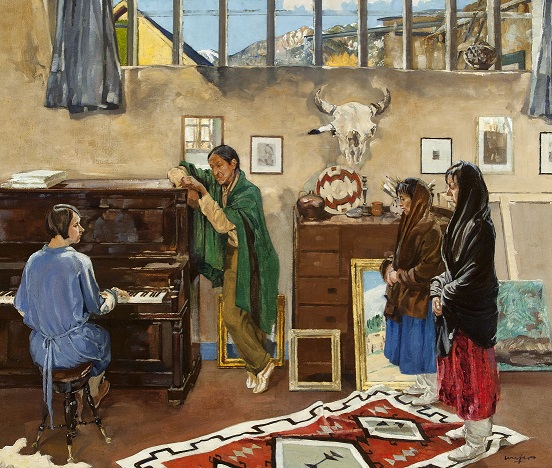New, exclusive exhibition examines relationship between people and place
January 16, 2024Interior Lives offers sumptuous paintings, decorative arts, and more on February 17
The Columbia Museum of Art announces Interior Lives: Modern American Spaces, 1890–1945, on view Saturday, February 17, through Sunday, May 12, 2024. Organized by the CMA, Interior Lives examines the relationships between architectural space and inner life during a pivotal period in American history. The new exhibition will be feted with an afternoon of art activities and talks at the opening celebration on Saturday, February 17.
“This exhibition asks a simple question at its core: what can interior scenes, rendered through the eyes of artists, tell us about the lives of those who inhabit them?” says CMA Senior Curator Michael Neumeister. “While Interior Lives does not present a comprehensive view of a time or a nation, the selections reveal something about how people live, adapt, and triumph in the face of trying circumstances.”
Through the lenses of interior scenes and material culture, Interior Lives explores the ways everyday Americans lived, worked, played, and evolved their identities in the first half of the 20th century. Homes, workplaces, and the spaces between were newly envisioned in response to socioeconomic and technological shifts. American artists, many of whom continued to work in a representational style, bore witness to the inception of a modern world and interpreted it as it manifested before them. The works on view in this exhibition — primarily portraits, genre scenes, and still lifes — are often modest in scale and humble in subject yet penetrating in their cultural and psychological implications.
“For so many people, the pandemic changed the relationship between domestic space and the workplace,” says Neumeister. “With this show, we were inspired to look at a different period in history when those kinds of relationships were also evolving in unique ways. Through the eyes of artists, we get a new sense of how our environment shapes us, and also how we shape our environment in response to the world.”
The exhibition takes the 1890s as its starting point, a decade that encompassed the late Gilded Age and saw the beginnings of the Progressive Era. It extends through the end of World War II, when the United States entered a new period of global influence and when abstraction took over as the dominant artistic style. Over the course of these six decades, the widespread implementation of the telephone, the building of mass transit systems, and the proliferation of industrially manufactured goods inspired a new, rapid pace of life.
“In America, we have a unique record of artists synthesizing modern experiences in a realist manner,” adds Neumeister. “It allows us to present a wonderful range of human emotion in this show.”
Interior Lives features more than 50 paintings, photographs, works on paper, and decorative arts, and is organized into four thematic sections: “How the Upper Half Lives,” “Labor, Leisure, and Liminal Space,” “Objects and Personas,” and “Faith, Family, and Community.” This multi-lender exhibition includes works by Milton Avery, Cecilia Beaux, Hilda Belcher, William Merritt Chase, Walter Gay, Edwin Harleston, Childe Hassam, Richard Samuel Roberts, Raphael Soyer, and Walter Ufer, among others.
Interior Lives: Modern American Spaces, 1890– 1945 is organized by the Columbia Museum of Art and presented through the support of our generous sponsors and grantors. Bronze Sponsor: Councilwoman Allison Terracio, Richland County Council. Supporting Sponsors: Hannah and Ron Rogers; Dr. Suzanne R. Thorpe and Dr. John W. Baynes. Contributing Sponsor: William Bodine. Friend Sponsors: Barbara B. Boyd; Dr. and Mrs. Benjamin M. Gimarc; Hotel Trundle; Joseph Bruce. Patron Sponsors: Haynsworth, Sinkler, Boyd; Suzi and Robert Clawson; Beth and Matthew Richardson. Grantors: City of Columbia; Experience Columbia SC; Richland County Government; South Carolina Arts Commission; Discover South Carolina. Additional support from The Nord Family Foundation.
Learn more at columbiamuseum.org.













